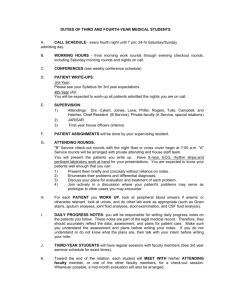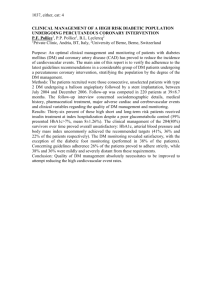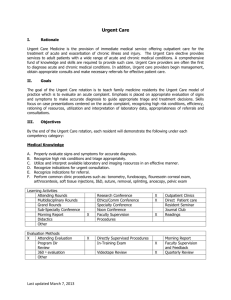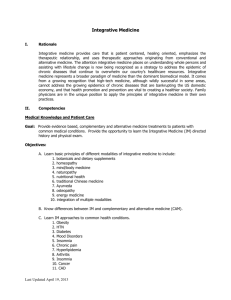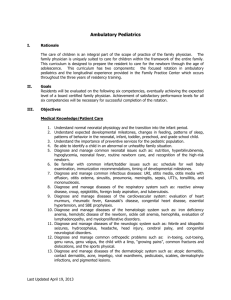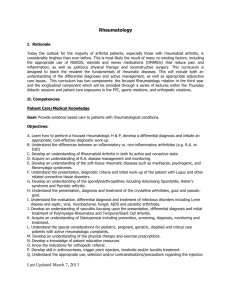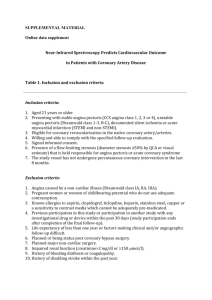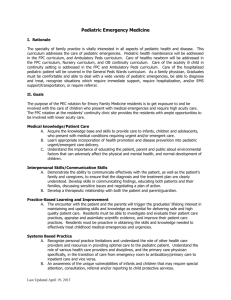Cardiology - Department of Family & Preventive Medicine
advertisement
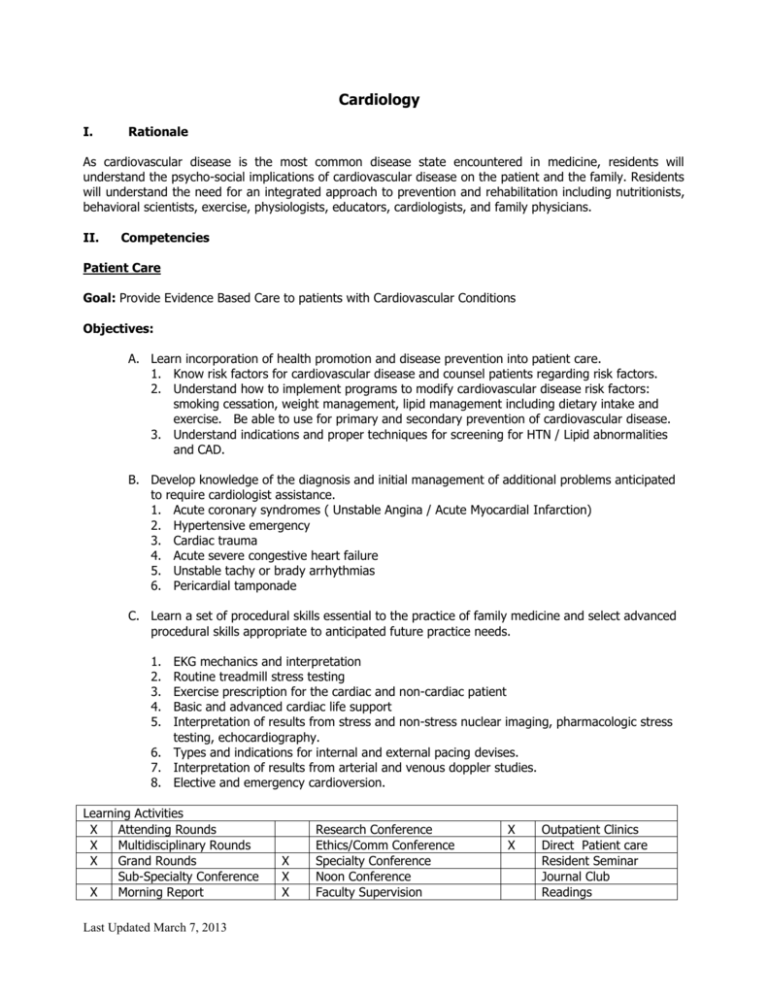
Cardiology I. Rationale As cardiovascular disease is the most common disease state encountered in medicine, residents will understand the psycho-social implications of cardiovascular disease on the patient and the family. Residents will understand the need for an integrated approach to prevention and rehabilitation including nutritionists, behavioral scientists, exercise, physiologists, educators, cardiologists, and family physicians. II. Competencies Patient Care Goal: Provide Evidence Based Care to patients with Cardiovascular Conditions Objectives: A. Learn incorporation of health promotion and disease prevention into patient care. 1. Know risk factors for cardiovascular disease and counsel patients regarding risk factors. 2. Understand how to implement programs to modify cardiovascular disease risk factors: smoking cessation, weight management, lipid management including dietary intake and exercise. Be able to use for primary and secondary prevention of cardiovascular disease. 3. Understand indications and proper techniques for screening for HTN / Lipid abnormalities and CAD. B. Develop knowledge of the diagnosis and initial management of additional problems anticipated to require cardiologist assistance. 1. Acute coronary syndromes ( Unstable Angina / Acute Myocardial Infarction) 2. Hypertensive emergency 3. Cardiac trauma 4. Acute severe congestive heart failure 5. Unstable tachy or brady arrhythmias 6. Pericardial tamponade C. Learn a set of procedural skills essential to the practice of family medicine and select advanced procedural skills appropriate to anticipated future practice needs. 1. 2. 3. 4. 5. EKG mechanics and interpretation Routine treadmill stress testing Exercise prescription for the cardiac and non-cardiac patient Basic and advanced cardiac life support Interpretation of results from stress and non-stress nuclear imaging, pharmacologic stress testing, echocardiography. 6. Types and indications for internal and external pacing devises. 7. Interpretation of results from arterial and venous doppler studies. 8. Elective and emergency cardioversion. Learning Activities X Attending Rounds X Multidisciplinary Rounds X Grand Rounds Sub-Specialty Conference X Morning Report Last Updated March 7, 2013 X X X Research Conference Ethics/Comm Conference Specialty Conference Noon Conference Faculty Supervision X X Outpatient Clinics Direct Patient care Resident Seminar Journal Club Readings Didactics Other Evaluation Methods X Attending Evaluation X Program Dir Review X 360 ᵒ evaluation Other X Procedures X X Directly Supervised Procedures In-Training Exam X X Videotape Review Morning Report Faculty Supervision and Feedback Quarterly Review Medical Knowledge Goal: Develop a broad knowledge base of symptoms, physical exam, diagnoses and interventions Objectives: A. Attain mastery of the following knowledge areas: 1. 2. 3. 4. 5. 6. 7. 8. 9. 10. 11. 12. 13. 14. 15. 16. 17. 18. 19. Normal anatomy and physiology Common variants of growth and development Detailed history and physical Evaluation of the pre-operative patient for cardiovascular disease and management of the cardiac patient pre-operatively. Coronary artery disease- stable and unstable angina, myocardial infarction, and sudden death Hypertension- mild, moderate, severe, urgent, and emergency Congestive heart failure-systolic and diastolic Common cardiac murmurs Cardiac risk stratification Indications for non-invasive and invasive cardiac evaluation Indications for SBE prophylaxis Common arrhythmia's/palpitations Stable cardiomyopathy Understand issues in selection and risks of performing PTCA and bypass grafting Thromboembolic disease Peripheral vascular disease Cardiovascular changes in the athlete Pericarditis Endocarditis Learning Activities X Attending Rounds X Multidisciplinary Rounds X Grand Rounds Sub-Specialty Conference X Morning Report X Didactics Other Evaluation Methods Last Updated March 7, 2013 X X X X Research Conference Ethics/Comm Conference Specialty Conference Noon Conference Faculty Supervision Procedures X X X Outpatient Clinics Direct Patient care Resident Seminar Journal Club Readings X X Attending Evaluation Program Dir Review 360 ᵒ evaluation Other X X Directly Supervised Procedures In-Training Exam X X Videotape Review X Morning Report Faculty Supervision and Feedback Quarterly Review Practice Based Learning and Improvement Goal: The resident should develop skills in evaluating their own patient care, appraising and assimilation of scientific evidence to improve patient care. Objectives: A. B. C. D. E. Identify resources for personal education. Develops a plan for ongoing education. Identify Point of Care learning resources. Utilize Electronic Medical Records Decision aid tools and templates for patient care. Recognizes strengths and weaknesses of knowledge and skills in self and others. Learning Activities X Attending Rounds X Multidisciplinary Rounds X Grand Rounds Sub-Specialty Conference Morning Report X Didactics Other Evaluation Methods X Attending Evaluation X Program Dir Review X 360 ᵒ evaluation Other X X Research Conference Ethics/Comm Conference Specialty Conference Noon Conference Faculty Supervision Procedures Directly Supervised Procedures In-Training Exam Videotape Review X X X Outpatient Clinics Direct Patient care Resident Seminar Journal Club Readings Morning Report Faculty Supervision and Feedback Quarterly Review Interpersonal and Communication Skills Goal: Residents will develop and demonstrate effective information exchange and teaming with patients, their families, and other health professionals. Objectives: A. Develop skills for interviewing that allow accurate, complete collection of information regarding symptoms, family, and community environment that affect the patient's cardiovascular health. B. Develop skills in communicating results, educating patients and their families, dealing with sensitive issues for patients and families, and negotiating a plan of treatment with the patient and family. Last Updated March 7, 2013 C. Residents will understand the need for an integrated approach to prevention and rehabilitation including nutritionists, behavioral scientists, exercise, physiologists, educators, cardiologists, and family physicians. Learning Activities X Attending Rounds X Multidisciplinary Rounds Grand Rounds Sub-Specialty Conference X Morning Report Didactics Other Evaluation Methods X Attending Evaluation X Program Dir Review X 360 ᵒ evaluation Other X Research Conference Ethics/Comm Conference Specialty Conference Noon Conference Faculty Supervision Procedures X X Directly Supervised Procedures In-Training Exam X X X Videotape Review X Outpatient Clinics Direct Patient care Resident Seminar Journal Club Readings Morning Report Faculty Supervision and Feedback Quarterly Review Professionalism Goal: Residents will demonstrate a commitment to carrying out professional responsibilities, adherence to ethical principles, and sensitivity to a diverse patient population. Objectives: A. Demonstrate integrity, honesty, respect and a commitment to excellence in all activities. B. Demonstrate sensitivity, respect and adapt appropriately to the social and cultural issues of each patient. C. Display initiative and resourcefulness in patient care and in solving problems. D. Be timely in attendance of activities and completion of tasks. Learning Activities X Attending Rounds X Multidisciplinary Rounds X Grand Rounds Sub-Specialty Conference X Morning Report Didactics Other: Evaluation Methods X Attending Evaluation X Program Dir Review X 360 ᵒ evaluation Other Last Updated March 7, 2013 X X Research Conference Ethics/Comm Conference Specialty Conference Noon Conference Faculty Supervision Procedures X X Outpatient Clinics Direct Patient care Resident Seminar Journal Club Readings Directly Supervised Procedures In-Training Exam X X Videotape Review X Morning Report Faculty Supervision and Feedback Quarterly Review Systems Based Practice Goal: demonstrate an awareness of and responsiveness to the larger context and system for health care and the ability to effectively call on system resources to provide care that is of optimal value Objectives: A. Utilize and understand the importance of appropriate referral or consultation with cardiologists or cardiothoracic surgeons. B. Support of the individual and family through consultation, evaluation, treatment, and rehabilitation. C. Understand the psychosocial and economic impact of cardiovascular disease on the individual and family and use of the health care system to assist as needed. D. Learns most cost effective ways to manage cardiovascular patients. Learning Activities X Attending Rounds X Multidisciplinary Rounds Grand Rounds Sub-Specialty Conference Morning Report Didactics Other Evaluation Methods X Attending Evaluation X Program Dir Review X 360 ᵒ evaluation Other III. X Outpatient Clinics Ethics/Comm Conference Specialty Conference Noon Conference Faculty Supervision Procedures X Direct Patient care Resident Seminar Journal Club Readings Directly Supervised Procedures In-Training Exam Videotape Review X X Morning Report Faculty Supervision and Feedback Quarterly Review Instructional Strategies (see above) A. B. C. D. E. F. IV. X X Research Conference Direct patient care of cardiology service patients Direct patient care of continuity clinic patients Teaching during patient rounds Cardiology lectures / conferences Independent reading Procedural learning (see above list) Evaluation Strategies (see above) A. B. C. D. E. F. H. Observation by Attending, fellow and residents End of rotation evaluation from the inpatient cardiology service at CLH. Procedure documentation by the resident Conference attendance In-training exam profiles Resident evaluation of rotation and faculty Completion of required readings and scoring >90% on open book Monograph quizzes Last Updated March 7, 2013 V. Implementation Strategies Interns rotate on the inpatient cardiology service at Crawford Long Hospital for a four week block. Location: Crawford Long Hospital Internal Medicine Morning Report is located in Classroom 5 of the Medical Office Tower. Report at 8:00 on first day of rotation. Refer to intern survival guide for specific instructions to finding the classroom (Resident link under www.fpm.emory.edu) Contact: Crawford Long Internal Medicine Chief Resident Family Practice Center: Continuity clinic is ½ day week Call: There is no call responsibility at CLH Call responsibility is with the Emory Dunwoody Hospital on the Family Medicine Service, typically 2 weekend calls in the block. No weekday call Supervision: CLH Cardiology Service Attending / Fellow / Resident Responsible Party: Jerre Lutz, MD Medical Director The Emory Clinic 1365 Clifton Road Emory Campus (404) 778-4351 ofc (404) 778-3417 fax Contact: Michelle (assistant) michelle.d.brown@emoryhealthcare.org 404-778-2165 ofc # Conferences: Morning report on M-F @ CLH Grand Rounds on Tuesday @ EUH Thursday AM didactics @ Emory Dunwoody Hospital Noon conferences at CLH VI. Bibliography Reading list: AAFP Monographs Update on Heart Failure (#298), Hypertension (#305), Perioperative Care (#263), CAD/MI (#270), Valvular Heart Disease (#397), Arrythmias (#391) Dubin D. Rapid Interpretation of EKG's: An Interactive Course: Cover Pub.; 2000. American Family Physician Collection of Articles on Coronary Artery Disease/Coronary Heart Disease available at http://www.aafp.org/afp/topicModules/viewTopicModule.htm?topicModuleId=4 Accessed on December 3, 2012. Last Update: 11/29/2012 Screening and Diagnosis 1. The Use of Coronary Computed Tomography Angiography to Rule Out CAD in the ED [AFP Journal Club] (11/15/2012) Last Updated March 7, 2013 2. Using Nontraditional Risk Factors in Coronary Heart Disease Risk Assessment [Putting Prevention into Practice] (02/15/2011) 3. Using Nontraditional Risk Factors in Coronary Heart Disease Risk Assessment: Recommendation Statement [U.S. Preventive Services Task Force] (02/15/2011) 4. Can ECG Rule Out ACS if Performed While the Patient Is Having Chest Pain? [AFP Journal Club] (11/15/2010) 5. Global Risk of Coronary Heart Disease: Assessment and Application (08/01/2010) 6. AHA Guidelines on Cardiac CT for Assessing Coronary Artery Disease [Practice Guidelines] (03/01/2008) 7. Cardiomyopathy: An Overview (05/01/2009) 8. Diagnosis of Acute Coronary Syndrome (07/01/2005) 9. Noninvasive Cardiac Imaging (04/15/2007) 10. Update on Exercise Stress Testing (11/15/2006) 11. Radiologic Evaluation of Acute Chest Pain—Suspected Myocardial Ischemia (08/15/2007) 12. Contemporary Management of Angina: Part I. Risk Assessment (12/01/1999) Prevention 1. AHA Updates Guidelines on CVD Prevention in Women [Practice Guidelines] (01/01/2012) 2. Aspirin for the Prevention of Cardiovascular Disease: Recommendation Statement [U.S. Preventive Services Task Force] (06/15/2011) 3. Aspirin for the Prevention of Cardiovascular Disease [Putting Prevention into Practice] (06/15/2011) 4. Primary Prevention of CVD: Physical Activity [Clinical Evidence Handbook] (07/15/2010) 5. Diets for Cardiovascular Disease Prevention: What Is the Evidence? (04/01/2009) 6. Preventing Cardiovascular Disease in Women (10/15/2006) 7. Hormone Therapy for the Prevention of Chronic Conditions in Postmenopausal Women [Putting Prevention into Practice] (12/15/2005) 8. Hormone Therapy for the Prevention of Chronic Conditions in Postmenopausal Women [U.S. Preventive Services Task Force] (07/15/2005) 9. Should We Use Multiple Risk Factor Interventions for the Primary Prevention of Coronary Heart Disease? [Cochrane for Clinicians] (07/15/2002) Treatment ACUTE 1. Drug-Eluting Coronary Artery Stents (12/01/2009) 2. ACC/AHA Guideline Update for the Management of ST-Segment Elevation Myocardial Infarction (06/15/2009) 3. Acute Coronary Syndrome (Unstable Angina and non-ST Elevation Myocardial Infarction) [Clinical Evidence Handbook] (08/15/2009) 4. Unstable Angina and Non-ST- Segment Elevation Myocardial Infarction: Part I. Initial Evaluation and Management, and Hospital Care (08/01/2004) 5. Unstable Angina and Non-ST-Segment Elevation Myocardial Infarction: Part II. Coronary Revascularization, Hospital Discharge, and Post-Hospital Care (08/01/2004) 6. Heparins for Unstable Angina and Non-ST-Segment Elevation Myocardial Infarction [Cochrane for Clinicians] (04/01/2009) 7. Early Invasive Therapy or Conservative Management for Unstable Angina or NSTEMI? [Cochrane for Clinicians] (01/01/2007) 8. Aspirin Combined with Clopidogrel (Plavix) Decreases Cardiovascular Events in Patients with Acute Coronary Syndrome [Cochrane for Clinicians] (12/01/2007) CHRONIC 1. Adding ACE Inhibitors or ARBs to Standard Therapy for Stable Ischemic Heart Disease [Implementing AHRQ Effective Health Care Reviews] (07/01/2012) Last Updated March 7, 2013 2. Medical Management of Stable Coronary Artery Disease (04/01/2011) 3. AHA Releases Guidelines for Hypertension Management in Adults with or at Risk of CAD [Practice Guidelines] (07/15/2008) 4. Secondary Prevention of Coronary Artery Disease (02/01/2010) 5. Exercise-Based Rehabilitation for Coronary Heart Disease [Cochrane for Clinicians] (08/01/2004) 6. Cardiovascular Risk Reduction in Children [Practice Guidelines] (06/15/2007) 7. Ranolazine (Ranexa) for Chronic Angina [STEPS] (02/15/2007) 8. Nutritional Assessment and Counseling for Prevention and Treatment of Cardiovascular Disease (01/15/2006) 9. Cardiac Rehabilitation (11/01/2009) 10. Prognosis for Patients Undergoing Coronary Angioplasty [Point-of-Care Guides] (11/15/2004) 11. Is Prasugrel More Effective Than Clopidogrel in Patients with Acute Coronary Syndrome Scheduled for PCI? [AFP Journal Club] (12/01/2008) 12. Contemporary Management of Angina: Part II. Medical Management of Chronic Stable Angina (01/01/2000) 13. ACC/AHA Revise Guidelines for Coronary Bypass Surgery [Practice Guidelines] (05/01/2000) Complications and Special Situations 1. AHA Releases Statement on Sexual Activity and Cardiovascular Disease [Practice Guidelines] (12/01/2012) 2. Beta Blockers and Noncardiac Surgery: Why the POISE Study Alone Should Not Change Your Practice [AFP Journal Club] (03/15/2010) 3. Preparation of the Cardiac Patient for Noncardiac Surgery (03/01/2007) 4. Right Ventricular Infarction: Specific Requirements of Management (10/15/1999) Last Updated March 7, 2013

